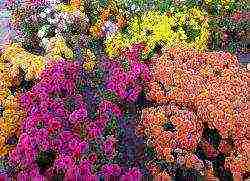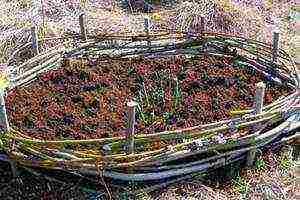Content
In 1950, Robert and Helena de Balder, first bred such a wonderful variety as the Paniculata Hydrangea, Unic. In 1993, the cultivar received its first AGM award from the Royal Horticultural Society.
This variety is considered the largest among all the subspecies of this family.
The plant reaches a height of almost three meters, and its wide branches sometimes spread up to five meters in width.
Therefore, when landing, it is worth considering these proportions and adhering to the distance at least a little. It looks very beautiful and harmonious in parks and city gardens, perfectly tolerates urban pollution, and will decorate any flower bed with its airy beauty.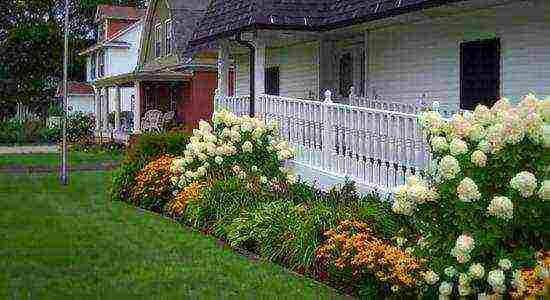
Variety Unique flowering
Hydrangea Unique blooms at the end of July, and pleases its owner until the very end of September. Inflorescences reach 30 centimeters in length. They are collected in a wide-conical shape, and hang beautifully from its branches. Before blooming, the flower turns pink. The inflorescences are sterile, located at the end of the shoot. In order for the flowering to be abundant, and the growth to be intense, the hydrangea must be watered abundantly.
But, it is worth making sure that the ground at its base does not become swampy or green.
Gardeners really like the fact that hydrangeas do not require any special care, they just need to be watered on time, and, if necessary, covered in the winter season, occasionally cutting off the shoots in autumn or spring.
The green leaves are ovoid and sometimes grow in whorls of 3. The edges are dentate, the structure of the leaf itself is rough. In autumn, their color does not change significantly. The length of the leaf can reach 14 centimeters with a width of up to 8 cm.
Hydrangea Unique soil and fertilizer
The soil should be fertile, slightly acidic or neutral, in which case the beauty will feel comfortable in her own environment, comfortable and wonderful. Despite the fact that paniculata love warmth, you still need to plant it in a place where there is no sun in the afternoon. You can feed the plant with fertilizers when the buds have just begun to form, as well as a couple of times during the summer.
Hydrangea paniculata Unique reproduction

The main method of propagation is cuttings. At the same time, cuttings can only be made at the very beginning of June. You need to choose a stalk with 5-6 nodes, then cut off the leaves from the lower two, and dig into loose soil with sufficient moisture for about 2 nodes. Cutting off the leaves by two-thirds, cover the stalk with a jar. Having landed them in the shade, it is necessary to check the condition of the soil every day, checking it for moisture.
Hydrangea paniculata Unique planting and pruning
For planting, it is best to choose the place that is most protected from cold weather and winds. This variety is more drought tolerant than others, but still prefers regular watering.
If there are fruit trees nearby, then it is best to plant it in some other place.
In urban conditions, it develops well.
Every spring, the shrub must be properly and properly pruned. Thus, old and diseased shoots are removed, and last year's shoots are cut off by 2/3 of the entire length.
Hydrangea paniculata Unique in the landscape
It is actively used in landscaping. With its help, beautiful compositions are created, as well as hedges are being erected. This variety is suitable for single planting, and for decorating huge open spaces in a group.She, in this case, acts as a huge, tall mixborder.
Hydrangea Unique is one of the largest varieties of the hydrangea family. It was bred by the world famous botanist couple de Balder (Robert and Helena), in the city of Antwerp in the middle of the twentieth century. Forty three years after his "birth", in 1993, he was awarded the Award of Garden Merit, which is awarded by the Royal Horticultural Society. For its excellent decorative properties, this shrub fell in love with gardeners from many countries.
Description of the flower
Hydrangea paniculata Unic is a deciduous, highly spreading ornamental shrub, reaching up to three meters in height. Sometimes its elastic branches with brown-red shoots can grow up to five meters wide. Therefore, under the weight of the peduncles, they often bend to the ground.
Hydrangea Unique bloom can be observed from the third decade of July to the end of September.
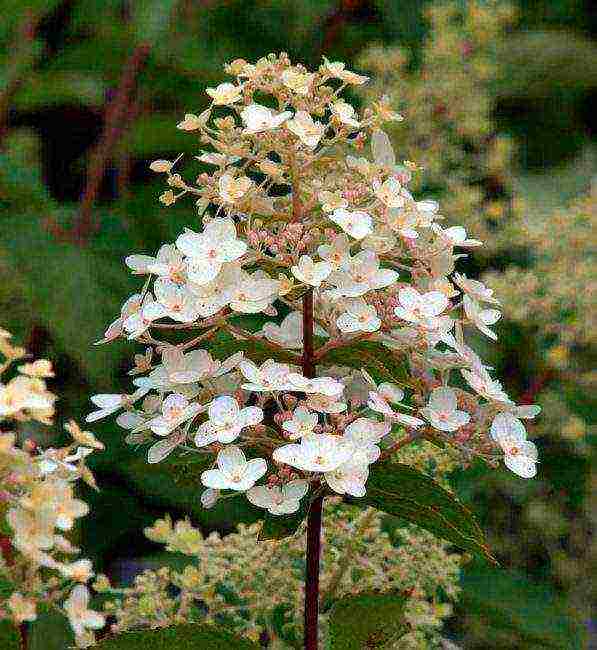 Large snow-white inflorescences, up to thirty centimeters long, have a conical shape and are somewhat reminiscent of panicles. Their diameter is about twenty-six centimeters. During the flowering period, the color range of the bush changes: from pale white to pink. The plant does not bear fruit. Hydrangea grows well in protected sunny areas and in partial shade, resistant to low temperatures (up to thirty degrees below zero).
Large snow-white inflorescences, up to thirty centimeters long, have a conical shape and are somewhat reminiscent of panicles. Their diameter is about twenty-six centimeters. During the flowering period, the color range of the bush changes: from pale white to pink. The plant does not bear fruit. Hydrangea grows well in protected sunny areas and in partial shade, resistant to low temperatures (up to thirty degrees below zero).
Young shrubs in the early years are less frost-hardy, therefore, they are covered for the winter period.
Over the years, the frost resistance of the plant increases. With proper care, the bush grows up to twenty centimeters per year.
The leaves of a deep green hue are ovoid, jagged at the edges, rough to the touch. Approximate dimensions: eight centimeters wide and fourteen long. They are oppositely located. Sometimes they can be collected in whorls of three pieces. In the autumn period they do not turn yellow, but only do not significantly change their color. The root part is superficial, well developed with a large number of small rhizomes. Forms shoots on light soil.
back to content ↑ Planting and care
Planting of Unicorn hydrangeas in open ground is carried out in spring or autumn. The optimum age for a young seedling is two to three years. When planting plants, a certain distance between them (at least three meters) should be observed, taking into account the dimensional characteristics of already mature bushes. Hydrangeas grow well and bloom profusely on fertile acidic, slightly acidic or neutral soil. Calcareous soils are "contraindicated" for them. For disembarkation, it is recommended to choose an area that is most protected from drafts.
back to contents ↑ Landing
Initially, you need to dig a hole with a diameter and depth of about 50-60 centimeters. A ten centimeter drainage layer is laid on its bottom. Shards of a clay pot, pieces of broken brick, small stones are excellent as drainage. Top covered with a fertile soil mixture and watered with one bucket of water.
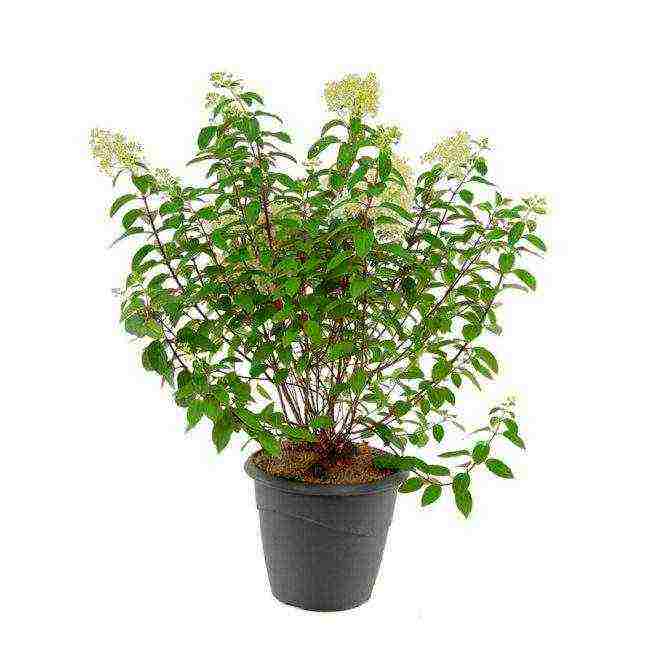 Next, you need to put a seedling and carefully distribute the root system over the fossa. It is important to remember that the root collar must be at ground level. They fill it up with the rest of the earth, tamp it and wate it again with one bucket of water. This variety is considered one of the unpretentious ones, so even a beginner can take care of the planted hydrangea.
Next, you need to put a seedling and carefully distribute the root system over the fossa. It is important to remember that the root collar must be at ground level. They fill it up with the rest of the earth, tamp it and wate it again with one bucket of water. This variety is considered one of the unpretentious ones, so even a beginner can take care of the planted hydrangea.
back to contents ↑ Watering
The first days after planting, the plant requires more reverent care. Frequent watering is required. Once it is in place, it is enough to water it five to seven times a season. In very dry weather, periodic spraying of the bushes is recommended. To obtain the maximum result, the soil around the bush is loosened to a depth of up to five centimeters, and weeds are removed.
In order to prevent their strong growth around the bush, mulching material can be used, which also retains moisture well at the roots and prevents the soil from drying out.
to the content ↑ Top dressing
It is advised to fertilize panicle hydrangea throughout the growing season (except for winter), but no more than three times a season. The first fertilization cycle begins two to three days after planting. Rotten manure is excellent as a top dressing. You can also use mineral fertilizers. In the spring they are fed with nitrogenous substances, in the summer they contain potassium and phosphorus, which contribute to active growth and flowering. It is allowed to water under the rhizomes and along the crown with potassium permanganate of low concentration in order to increase the strength of the shoots.
back to contents ↑ Cropping
In temperate climates, circumcision is carried out in the spring before the start of active sap flow. In the course of these measures, obsolete flowers are removed to real strong buds, the shoots of the previous year are shortened by a third, diseased and weak branches are cut out at the root, as well as those that are densely located next to each other. Some people remove dead buds and form a bush in the fall. However, experts categorically do not recommend doing this, arguing that they are a kind of frost protection for new buds.
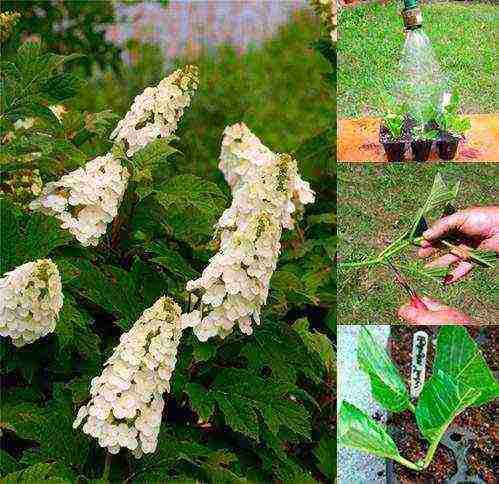 In non-severe winters, the root system of the plant is covered with leaves, straw, dry grass, sawdust, spruce branches, and sprinkled with snow. In severe frosts, they are additionally wrapped with a covering material (spunbond) or film.
In non-severe winters, the root system of the plant is covered with leaves, straw, dry grass, sawdust, spruce branches, and sprinkled with snow. In severe frosts, they are additionally wrapped with a covering material (spunbond) or film.
back to content ↑ Cultivation of hydrangea
The Unicorn hydrangea is propagated in several ways. The most common is grafting. The best period for cutting cuttings is the first half of June. To do this, choose the strongest stems, which are kept in water for five to seven days. Then they are cut into pieces, each of which should contain about five to six nodes. Planted on two or three nodes in a container with a loose substrate, consisting of
sand and peat. Cover with a plastic bottle, glass jar, or plastic bag and store in a cool place.
The air temperature in a kind of greenhouse should not exceed twenty degrees Celsius above zero.
Airing and watering are performed daily. To prevent decay, the soil mixture is watered with a pink manganese solution every seven days. After the sprouts appear, the container is transferred to a bright place. Thus, they are kept in open ground until the spring planting.
Other methods of reproduction are used much less often.
Dividing a bush consists in digging up a plant, cutting its roots into several parts. Each of them should have about three active kidneys. The newly formed bushes are planted in a soil of a suitable composition and constantly moistened. For propagation by layering, the branch is tilted to a small depression in the ground and sprinkled with soil. The cuttings are separated from the mother plant only after the emergence of new seedlings.
back to content ↑ Diseases and pests
The flower can "get sick" with chlorosis, septoria, gray rot, spotting (ascochitous or annular), ash, etc. In advanced stages, the bushes are taken out of the plot and burned, and the ground is treated with fungicides or a solution of potassium permanganate.
 This type of hydrangea can be attacked by aphids, slobbery pennies, spider mites, bedbugs, nettle weevils, scoops, gall nematodes and other pests.
This type of hydrangea can be attacked by aphids, slobbery pennies, spider mites, bedbugs, nettle weevils, scoops, gall nematodes and other pests.
In preventive measures, spraying with insecticidal preparations, as well as folk remedies, is periodically used. In the fight against large insects, glue-based traps are used.
To prevent the death of Yunika, it is recommended to balance the amount of fertilization and watering. And then she will thank the gardener with a gorgeous flowering for many seasons.
Similar articles:
Hydrangea Unique is a panicle hydrangea variety bred in Belgium by Helena and Robert de Belder in 1950.Since then, the Unique variety has become popular with gardeners around the world for its excellent decorative properties. In 1993 he was awarded the AGM Royal Horticultural Society Award.
General information
Description: panicle hydrangea of the Yunik variety is a shrub with a height of 1.5 to 2 meters, crown diameter - 2.5-3 meters. With good care, it grows well - up to 20 cm per year.
Shoots are straight, strong and tough, with brownish-red bark. The roots are shallow, well developed, with many small roots.

Hydrangea paniculata unique.
Leaves are oval, ovoid, green, dense with jagged edges, rather long - up to 15 cm in length and up to 8 cm in width.
The variety is distinguished by long flowering - from July to the end of September. Inflorescences are barren, cone-shaped, up to 30 cm long, located at the ends of the shoots. At the beginning of flowering, the flowers are milky white, gradually acquiring a pink tint.
The panicle hydrangea variety unik is distinguished by good frost resistance - up to -30 degrees.
Agrotechnics
For planting panicle hydrangeas of the Unicorn variety, it is better to choose a slightly shaded place, protected from strong winds and drafts. Unique from some other varieties of this species, Unique is that it can tolerate drought and lack of watering for some time, however, like all hydrangeas, it loves moist soil and careful care.
As for the composition of the soil, it is best to choose fertile soil with an acidic or slightly acidic reaction for planting it. The plant does not tolerate calcareous soils.
The Unique variety grows in a polluted city air, and is suitable for planting in city gardens and parks.
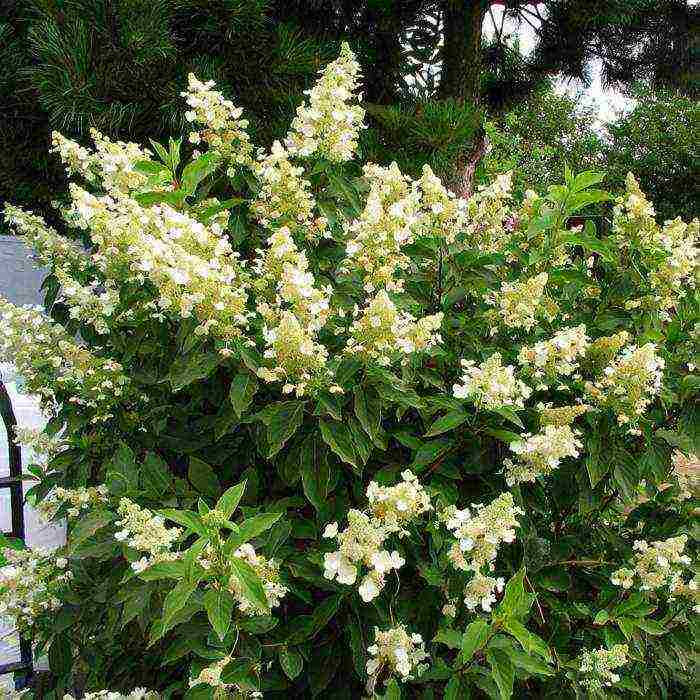
Planting a seedling of hydrangea paniculata Unic in open ground is carried out at the age of 2-3 years, in spring or autumn. Naturally, if it is difficult to guess with the arrival of cold weather, it is better to plant a bush in the spring.
For planting panicle hydrangeas of the Unicorn variety, a hole with dimensions of 40x40x50 cm is prepared on light soil; 50x50x60 cm on loamy cultivated soil; 60x60x70 cm on heavy clay soil.
At the bottom of the hole, drainage is made from broken clay bricks or small stones, a drainage layer is 10 cm.Then the top fertile soil layer is poured, 1 bucket of water is poured, a seedling is installed and the roots are straightened, while the root collar remains at the soil level. After planting, another 1 bucket of water is poured into the hole and the rest of the earth is poured, since its level will decrease after watering.
Now the newly planted Unicorn hydrangea needs care and attention. After watering and rain, the soil is carefully loosened to a depth of 5 cm, weeds are removed. So that they do not grow so much, the ground around the bush is mulched with any material suitable for these purposes.
The panicle hydrangea is fed with rotted manure or mineral fertilizers. Nitrogenous fertilizers are applied in the spring, at the beginning of the growing season, potassium-phosphorus fertilizers - in the summer.
At the very beginning of spring, pruning is carried out. After swelling of the buds, damaged branches are cut off, and healthy shoots are shortened by 2/3 of the length.
In autumn, caring for panicle hydrangea consists in pruning faded inflorescences and wrapping them up for the winter. If severe frosts are not expected, it will be enough to cover the roots with a layer of leaves or straw. In winter, after the first snowfall, the roots are additionally covered with snow.
If the winters in this area are harsh, the shelter for the winter should be more significant - the roots are also sprinkled with leaves, straw and snow, the above-ground part is wrapped in agrofibre. If this is not enough, a box is made over the plant, which is covered to the top with dry leaves, sawdust, shavings or needles, and covered with film or boards on top.
Reproduction
Propagate panicle hydrangea of the Unicorn variety by cuttings or dividing the bush. It is better to start propagation by cuttings in June. The stalk should have 5-6 internodes, the 2 lower leaves are cut off and the stalk is immersed in a loose, moist substrate of leafy earth and sand for 2 knots.The remaining leaves are cut in half, the container with cuttings is covered with a glass jar or a plastic bottle with a cut off bottom.
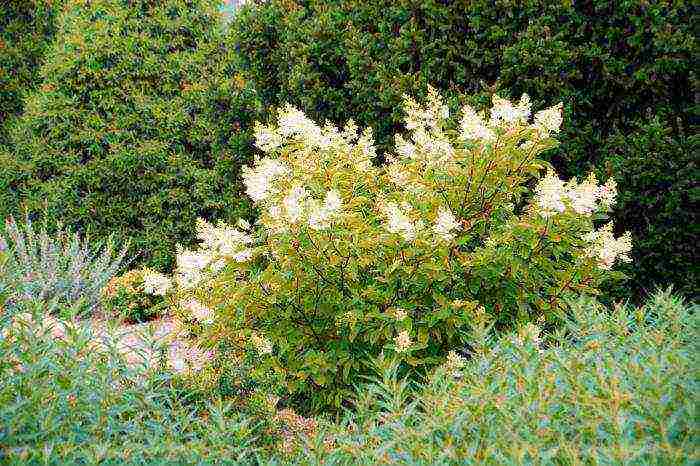
Care for cuttings during this period should consist of watering and airing, the soil should always be moist. And so that the cuttings do not start to rot, they should be watered once a week with a pink solution of potassium permanganate.
Cuttings of panicle hydrangea are planted in open ground after 2 years, all this time they are grown in a greenhouse or at home at a temperature of 15-20 degrees.
Diseases and pests
Hydrangea care means protection from disease and pests. The Yunik variety is susceptible to such pests as aphids, slobbering pennits, thrips, green bugs, spider mites, fawn leaf beetles, scoops, bronzovka, marsh long-stemmed mosquito, gall nematode. For prevention, the plant is sprayed from time to time with insecticides or folk remedies. For large insects, mechanical light or glue traps can be installed.
As for diseases, in addition to chlorosis, the Unicorn hydrangea can suffer from gray rot, cancer, powdery mildew, ring and ascochitous spotting, septoria. For treatment, fungicides and folk remedies are used. In some cases, if the disease is neglected, the plant must be removed and burned, and the soil under it must be disinfected with a solution of potassium permanganate or fungicides. In order to prevent the death of hydrangea, it is necessary to streamline watering and feeding, and for prevention, spray it with plant protection products at least once a month.
Hydrangea paniculata Unic is an ideal option for decorating a personal plot, park, flower bed. Luxurious snow-white hats will delight the eye from July to the end of September. The variety is considered the largest member of the family. In height, the shrub can reach almost 3 m, in width, powerful branches often spread out to a distance of 5 m. The diameter of the inflorescences is 30 cm. Before blooming, the buds acquire a pale pink hue. The flowers themselves, as a rule, are distinguished by amazing whiteness.
Unique, or, as many gardeners call it otherwise, Unique, was bred relatively recently. The variety was obtained by Belgian enthusiasts Robert and Elena de Belder in 1950. In 1993, the plant was awarded the most prestigious award of the English Royal Horticultural Society. After that, it quickly gained popularity in many countries, including Russia.
Hydrangea paniculata Unic is an ideal option for decorating a personal plot, park, flower bed. Luxurious snow-white hats will delight the eye from July to the end of September. The variety is considered the largest member of the family. In height, the shrub can reach almost 3 m, in width, powerful branches often spread out to a distance of 5 m. The diameter of the inflorescences is 30 cm. Before blooming, the buds acquire a pale pink hue. The flowers themselves, as a rule, are distinguished by amazing whiteness.
Unique, or, as many gardeners call it otherwise, Unique, was bred relatively recently. The variety was obtained by Belgian enthusiasts Robert and Helena de Belder in 1950. In 1993, the plant was awarded the most prestigious award of the English Royal Horticultural Society. After that, it quickly gained popularity in many countries, including Russia.
Care features
